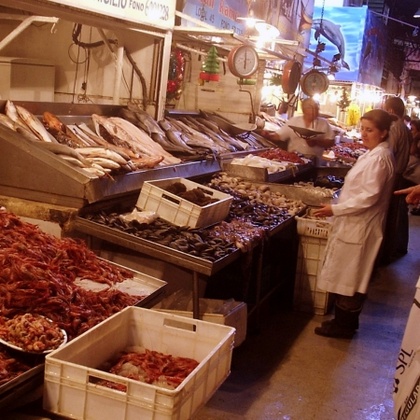Around Mercado and Estacion Mapocho
‘You’ll find several restaurants in the Market’s main hall, most of which offer exactly what visitors want: simple and authentic Chilean dishes with an emphasis on freshness.’
Two blocks north of Santo Domingo lies one of Santiago’s undying attraction, the Mercado Central. Although this has long been dethroned as the capital’s principal wholesale market, most visitors in search of a lively ambience, excellent food and vociferous fruiterers and fishmongers find themselves satisfied in this intricately ornate marketplace. Its origins can be traced back to the Mercado de Abastos which used to operate at the Plaza de Armas until 1817. That year, Bernardo O’Higgins, the then ruler of Chile, ordered the transfer of the market to a purposely built structure at the present-day site. The works for the current building started in 1864, including a roof structure manufactured in England in 1872.

As fresh as it gets at the Mercado Central
A recent drive to exploit the Market’s tourist potential has resulted in a partial loss of its original use. Nowadays, you’ll find several restaurants in the Market’s main hall, most of which offer exactly what visitors want: simple and authentic Chilean dishes with an emphasis on freshness. The stalls themselves continue to offer an unrivalled – if slightly overpriced – selection of fruit, vegetables and fish, making this a true ‘foodie’ heaven.
Another highlight of the area is the Estación Mapocho. This virtuously decorated railway station was designed by Emilio Jecquier and built in 1905 in commemoration of the 100th anniversary of the Chilean Independence. The station used to link the capital to both Valparaíso and Argentina, and was in service until 1987, when a boom in coach and air travel forced this section of the railway system out of business. Authorities then decided to transform the station into a venue for art exhibitions, concerts and conferences and the Estación Mapocho underwent refurbishment works that recovered some of Jecquier’s original style, which had deteriorated considerably over the years. Back to its original splendour, the building today hosts various events, from book fairs to fashion shows.
The station was built in an area of land that was once the natural riverbed of the Mapocho, and where authorities in the late 19th century decided to build the Northern railway. Such project affected the preservation of what was Santiago’s most emblematic bridge, Puente Cal y Canto which, despite public opposition, was demolished to make way for the station hall. The disappeared structure had been a masterpiece of colonial architecture, and the a few stone that remain can be seen inside the metro station of the same name. The Cal y Canto used to connect the centro histórico to what was denominated as La Chimba – a byword for ‘slums’ – or the underclass neighbourhood in colonial times. This is the precedent of today’s Recoleta and Patronato, two northern areas that have inherited much of the scruffiness of this singular area. Across the river, life is about tough business in whatever form it may come, from wholesale to street vending. This environment is overwhelming for Santiaguinos themselves, so don’t expect an easy ride if you choose to explore the city’s biggest fruit and vegetable market, La Vega.